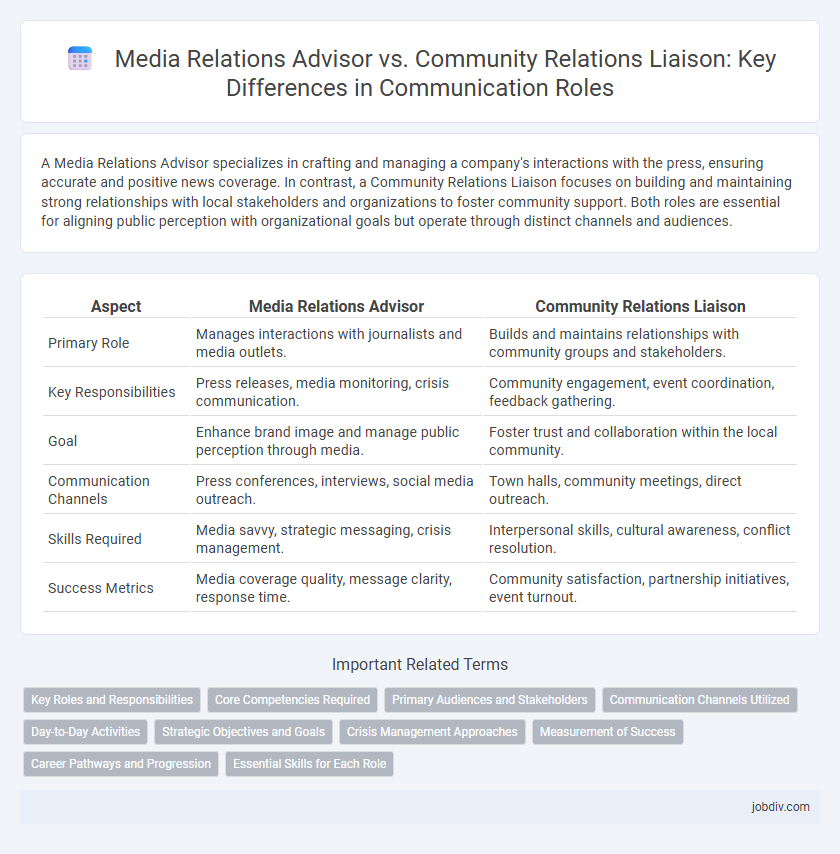A Media Relations Advisor specializes in crafting and managing a company's interactions with the press, ensuring accurate and positive news coverage. In contrast, a Community Relations Liaison focuses on building and maintaining strong relationships with local stakeholders and organizations to foster community support. Both roles are essential for aligning public perception with organizational goals but operate through distinct channels and audiences.
Table of Comparison
| Aspect | Media Relations Advisor | Community Relations Liaison |
|---|---|---|
| Primary Role | Manages interactions with journalists and media outlets. | Builds and maintains relationships with community groups and stakeholders. |
| Key Responsibilities | Press releases, media monitoring, crisis communication. | Community engagement, event coordination, feedback gathering. |
| Goal | Enhance brand image and manage public perception through media. | Foster trust and collaboration within the local community. |
| Communication Channels | Press conferences, interviews, social media outreach. | Town halls, community meetings, direct outreach. |
| Skills Required | Media savvy, strategic messaging, crisis management. | Interpersonal skills, cultural awareness, conflict resolution. |
| Success Metrics | Media coverage quality, message clarity, response time. | Community satisfaction, partnership initiatives, event turnout. |
Key Roles and Responsibilities
A Media Relations Advisor specializes in managing interactions with journalists, crafting press releases, and securing positive media coverage to enhance public perception. A Community Relations Liaison focuses on building strong relationships with local organizations, stakeholders, and residents to foster trust and support for the organization. Both roles require excellent communication skills but differ in their primary audiences and strategic objectives: media for public awareness and community for grassroots engagement.
Core Competencies Required
A Media Relations Advisor requires expertise in strategic communication, crisis management, and media monitoring to effectively manage press interactions and shape public narratives. Strong skills in message development, media outreach, and relationship-building with journalists are essential for influencing media coverage and maintaining a positive organizational image. Conversely, a Community Relations Liaison must excel in stakeholder engagement, cultural competency, and conflict resolution to foster trust and collaboration within diverse community groups.
Primary Audiences and Stakeholders
Media Relations Advisors primarily engage journalists, editors, and media outlets to shape public messaging and enhance brand visibility through press releases and media coverage. Community Relations Liaisons focus on local residents, community organizations, and civic leaders to build trust, address concerns, and foster collaborative partnerships at the grassroots level. Both roles target different primary audiences but align in advancing organizational reputation and stakeholder engagement.
Communication Channels Utilized
Media Relations Advisors primarily utilize press releases, media briefings, and social media platforms to engage journalists and influence public narratives. Community Relations Liaisons focus on direct communication channels such as town hall meetings, newsletters, and local events to foster community engagement and build trust. Both roles leverage tailored communication strategies to effectively reach their specific audiences and objectives.
Day-to-Day Activities
A Media Relations Advisor primarily manages press releases, coordinates interviews, and monitors media coverage to shape public perception daily. In contrast, a Community Relations Liaison engages directly with local groups, organizes events, and addresses public concerns to foster community trust and collaboration. Both roles require strong communication skills but target different audiences and channels to achieve their organizational goals.
Strategic Objectives and Goals
Media Relations Advisors focus on managing press interactions and enhancing brand visibility through targeted media campaigns, aiming to secure positive coverage and control public narratives. Community Relations Liaisons prioritize building long-term trust and engagement within local populations, aligning outreach efforts with organizational social responsibility objectives. Both roles drive strategic goals by cultivating relationships, but Media Relations Advisors emphasize external media impact while Community Relations Liaisons foster grassroots connections.
Crisis Management Approaches
A Media Relations Advisor specializes in managing communication strategies during crises by crafting targeted messages for press and media outlets, ensuring accurate and timely information dissemination to shape public perception. In contrast, a Community Relations Liaison focuses on direct engagement with local stakeholders and community groups, facilitating dialogue to address concerns and foster trust during emergencies. Effective crisis management integrates both roles to balance external media narratives with grassroots community support and responsiveness.
Measurement of Success
Media Relations Advisors measure success through metrics like media coverage volume, message penetration, audience reach, and sentiment analysis, emphasizing earned media impact. Community Relations Liaisons assess effectiveness by tracking community engagement levels, stakeholder feedback, program participation rates, and the strength of local partnerships. Both roles rely on qualitative and quantitative data but prioritize different communication channels and audience interactions for evaluation.
Career Pathways and Progression
Media Relations Advisors specialize in managing communication between organizations and the press, focusing on crafting press releases, handling media inquiries, and shaping public perception. Community Relations Liaisons concentrate on building and maintaining relationships with local stakeholders, facilitating community engagement and addressing public concerns. Career progression for Media Relations Advisors often leads to roles in corporate communications or public affairs, whereas Community Relations Liaisons may advance into public relations management or community development leadership positions.
Essential Skills for Each Role
Media Relations Advisors excel in strategic communication, mastering press releases, crisis management, and media pitching to shape public perception and maintain a positive organizational image. Community Relations Liaisons demonstrate strong interpersonal skills, cultural awareness, and grassroots engagement abilities to build trust, facilitate dialogue, and nurture relationships within diverse local populations. Both roles require excellent verbal and written communication skills, but Media Relations Advisors prioritize media-centric expertise while Community Relations Liaisons focus on direct community interaction and stakeholder collaboration.
Media Relations Advisor vs Community Relations Liaison Infographic

 jobdiv.com
jobdiv.com